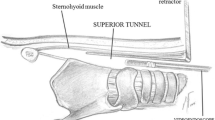Abstract
Surgical management of the nasopharynx is complex. Both traditional and endoscopic transnasal techniques are demanding. Purely transoral robotic nasopharyngectomy has been described but it needs a palatal splitting and is performed with an inferior to superior perspective with a difficult vision of the upper regions. The aim of this study is to investigate a new robotic surgical setting, which is able to overcome the actual limits. The DaVinci Surgical System was used in two cadavers. Dissection was carried out through a combined transnasal–transoral approach and a purely transoral procedure. A complete nasopharyngectomy was performed with both settings. Working and setting times are comparable. The combined approach avoids palatal spitting and permits a more panoramic view of the surgical field with an easier dissection of the upper areas. A robotic palatal sparing nasopharyngectomy is feasible. The combined transnasal–transoral setting seems to offer significant advantages with respect to traditionally purely transoral procedures.



Similar content being viewed by others
References
Fisch U (1983) The infratemporal fossa approach for nasopharyngeal tumors. Laryngoscope 93:36–44
Tu GY, Hu YH, Xu GZ, Ye M (1988) Salvage surgery for nasopharyngeal carcinoma. Arch Otolaryngol Head Neck Surg 114:328–329
Nuss DW, Janecka IP, Sekhar LN, Chandra N (1991) Craniofacial disassembly in the management of skull base tumors. Otolaryngol Clin North Am 24:1464–1484
Fee WE Jr, Roberson JB Jr, Goffinet DR (1991) Long term survival after surgical resection for recurrent nasopharyngeal cancer after radiotherapy failure. Arch Otolaryngol Head Neck Surg 117:1233–1236
Morton RP, Liavaag PG, McLean M, Freeman JL (1996) Transcervico-mandibulo-palatal approach for surgical salvage of recurrent nasopharyngeal cancer. Head Neck 18:352–358
Wei WI (2000) Salvage surgery for recurrent primary nasopharyngeal carcinoma. Crit Rev Oncol Hematol 33:91–98
Yoshizaki T, Wakisaka N, Murono S, Shimizu Y, Furukawa M (2005) Endoscopic nasopharyngectomy for patients with recurrent nasopharyngeal carcinoma at the primary site. Laryngoscope 115:1517–1519
Chen MK, Lai JC, Chang CC, Liu MT (2007) Minimally invasive endoscopic nasopharyngectomy in the treatment of recurrent T1–2a nasopharyngeal carcinoma. Laryngoscope 117:894–896
Castelnuovo P, Dallan I, Bignami M et al (2010) Nasopharyngeal endoscopic resection in the management of selected malignancies: ten-year experience. Rhinology 48:84–89
Hanna EY, Holsinger C, DeMonte F, Kupferman M (2007) Robotic endoscopic surgery of the skull base. A novel surgical approach. Arch Otolaryngol Head Neck Surg 133:1209–1214
Kupferman M, DeMonte F, Holsinger FC, Hanna E (2009) Transantral robotic access to the pituitary gland. Otolaryngol Head Neck Surg 141:413–415
Lee JY, O’Malley BW Jr, Newman JG et al (2010) Transoral robotic surgery of craniocervical junction and atlantoaxial spine: a cadaveric study. J Neurosurg Spine 12:13–18
Lee JY, O’Malley BW Jr, Newman JG et al (2010) Transoral robotic surgery of the skull base: a cadaver and feasibility study. ORL J Otorhinolaryngol Relat Spec 72:181–187
McCool RR, Warren FM, Wiggins RH, Hunt JP (2010) Robotic surgery of the infratemporal fossa utilizing novel suprahyoid port. Laryngoscope 120:1738–1743
O’Malley BW Jr, Quon H, Leonhardt FD, Chalian AA, Weinstein GS (2010) Transoral robotic surgery for parapharyngeal space tumors. J Otorhinolaryngol Relat Spec 72:332–336
Weinstein GS, O’Malley BW Jr, Hockstein NG (2005) Transoral robotic surgery: supraglottic laryngectomy in a canine model. Laryngoscope 115:1315–1319
Wei WI, Ho WK (2010) Transoral Robotic Resection of Recurrent Nasopharyngeal Carcinoma. Laryngoscope 120:2011–2014
Ozer E, Waltonen J (2008) Transoral robotic nasopharyngectomy: a novel approach for nasopharyngeal lesions. Laryngoscope 118:1613–1616
O’Malley BW Jr, Weinstein GS (2007) Robotic anterior and midline skull base surgery: preclinical investigations. Int J Radiat Oncol Biol Phys 69:S125–S128
Acknowledgments
We thank Katie Anderson for her invaluable support and expertise during dissection time and Mrs. Diana Elizabeth Hearn for her help in translation and revising the manuscript.
Conflict of interest
We state that all Authors have seen and approved the manuscript “Combined Transoral Transnasal Robotic-assisted Nasopharyngectomy: a cadaveric feasibility study”, that there is not conflict of interest, that neither the submitted paper nor any similar paper, in whole or in part, other than an abstract or preliminary communication, has been or will be submitted to or published in any other printed or digital publication. We declare that all Authors had full access to all the data in the study and take responsibility for the integrity of the data and the accuracy of the data analysis.
Author information
Authors and Affiliations
Corresponding author
Rights and permissions
About this article
Cite this article
Dallan, I., Castelnuovo, P., Montevecchi, F. et al. Combined transoral transnasal robotic-assisted nasopharyngectomy: a cadaveric feasibility study. Eur Arch Otorhinolaryngol 269, 235–239 (2012). https://doi.org/10.1007/s00405-011-1550-x
Received:
Accepted:
Published:
Issue Date:
DOI: https://doi.org/10.1007/s00405-011-1550-x




